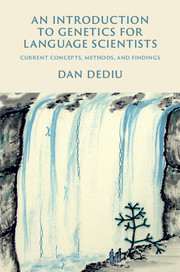Book contents
- Frontmatter
- Dedication
- Contents
- List of illustrations
- Acknowledgements
- 1 Introduction
- 2 Nature, nurture, and heritability
- 3 The molecular bases of genetics
- 4 Effects of genes on phenotype
- 5 Linkage disequilibrium and its role in finding genes
- 6 What do genes actually do?
- 7 The way forward: exome and genome sequencing
- 8 Population and evolutionary genetics
- 9 Interactions between genetic and cultural evolution
- 10 Conclusions, topics not covered, future directions
- Appendix The computer code
- References
- Index
- Glossary
5 - Linkage disequilibrium and its role in finding genes
Published online by Cambridge University Press: 05 April 2015
- Frontmatter
- Dedication
- Contents
- List of illustrations
- Acknowledgements
- 1 Introduction
- 2 Nature, nurture, and heritability
- 3 The molecular bases of genetics
- 4 Effects of genes on phenotype
- 5 Linkage disequilibrium and its role in finding genes
- 6 What do genes actually do?
- 7 The way forward: exome and genome sequencing
- 8 Population and evolutionary genetics
- 9 Interactions between genetic and cultural evolution
- 10 Conclusions, topics not covered, future directions
- Appendix The computer code
- References
- Index
- Glossary
Summary
Linkage disequilibrium (which we have encountered earlier in the book) strikes back as it is the basis of very powerful methods for finding genes involved in speech and language. We describe in more detail what linkage disequilibrium is and how it is used. We begin by looking at association studies, which use unrelated participants to find genetic loci correlated with variation in the phenotype, as well as a variant that uses familial groups (for example, the parents and an affected child); we will survey some recent examples of using association studies to discover genes relevant for language and speech. We then discuss linkage studies that use large families to pinpoint genes, focusing on the example of FOXP2. In this chapter we will encounter more statistics as we need to deal with many complications such as what happens when we test hundreds of thousands of genetic markers, and on how to interpret the results of association and linkage studies.
The concept of linkage disequilibrium (or the tendency for some loci to be transmitted non-independently) is extremely important in our hunt for the genes influencing phenotypes. We will discuss here the two main methods that use it, association and linkage studies, introducing also some statistical concepts fundamental to properly conducting such studies and interpreting their results.
What is linkage disequilibrium?
As we saw in Section 4, the sweet pea flower colour is controlled by a locus with alleles A (dominant, purple flowers) and a (recessive, red flowers). Another locus studied by Bateson, Saunders and Punnett in sweet pea controls the shape of pollen grains and has two alleles: B (dominant, long grains) and b (recessive, round grains). By crossing pure lines of homozygous plants with purple flowers and long grains, AABB plants, with homozygous plants with red flowers and round grains, aabb, they obtained, in the first generation (usually denoted F1), only heterozygous plants with purple flowers and long grains AaBb, as expected given the dominance relationships at these two loci.
- Type
- Chapter
- Information
- An Introduction to Genetics for Language ScientistsCurrent Concepts, Methods, and Findings, pp. 90 - 130Publisher: Cambridge University PressPrint publication year: 2015



